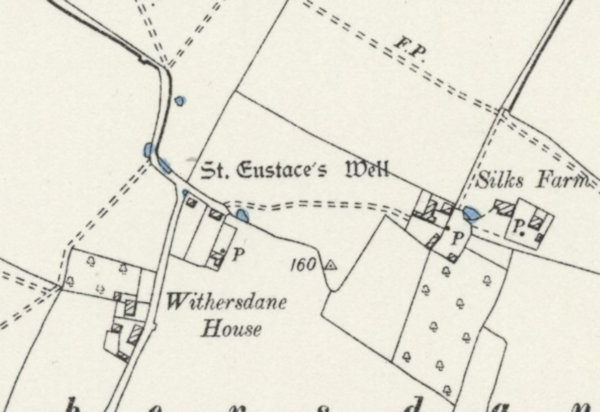 |
Dedication: Saint Eustace of Fly Location: Withersden Coordinates: 51.17508N, 0.94789W Grid reference: TR061458 Heritage designation: none |
 |
Dedication: Saint Eustace of Fly Location: Withersden Coordinates: 51.17508N, 0.94789W Grid reference: TR061458 Heritage designation: none |
Eustace of Fly was a 13th century missionary, and the abbot of St Germer de Fly in Beauvais, France. Pope Innocent III sent Eustace on a mission to southern England in the year 1200 after being impressed by Eustace's skills as a missionary in France. Eustace's first English mission was focused in the area around Canterbury, and it was during this time that he is said to have travelled to Withersden and to have blessed the well. Although this mission was not a great success, Eustace's saintly memory was evidently preserved in the local area long after he had returned to France. It is known for certain that St Eustace's Well existed at least by around 1240, and it almost certainly dates from the time of Eustace's visitation.
Quite unusually, the miracle associated with St Eustace's Well was documented no more than four decades after its purported occurence. This holy well is probably the only in England to have been recorded so shortly after its patron saint had visited the area, and proves that local cults developed quickly, at least by the 13th century. This incredibly early exposition of the well's legend was written by Matthew Paris, a 13th century monk at the Abbey of St Alban (now St Albans Cathedral), in a text known as the Chronica Majora; the original Latin text was transcribed and published in 1874:
|
Inter quos abbas de Flai nomine Eustachius, vir religiosus et literali scientia eruditus, regnum Angliae aggressus, multis ibidem miraculis choruscavit, Qui non longe a civitate Dorobornensi appulsus, in villa quae Wi appellatur, officium praedicationis incepit. Cumque fontem quendam ibidem benedixisset, Dominus ipsius meritis tantam in co infudit grantiam, ut ex solo illius gustu caeci visum, claudi gressum, muti loquelam, et surdi caelitus receperunt auditum, et quisquis debilis ex fonte cum fiducia bibens gavisus est se recepisse sanitatem. Venit itaque ad eum mulier quaedam, a daemonibus obsessa et quasi hydropico morbo inflata, petens ab eo sibi [restitui] sanitatem. Cui ille; "Confide, filia, et vade ad natatoria fontis de Wi, cui benedixit Dominus, et bibe ex eo, et recipies ilico sospitatem." Abiit mulier, et juxta viri Dei monita bibit, atque protinus in vomitum prorupit; ubi cunctis, qui ad fontem gratia curationis venerant, cernentibus, exierunt ex illa duo bufones magni et nigerrimi, qui, ut se daemones ostenderent, statim transformati sunt in canes immensos et nigros, et post paululum in formam conversi sunt asininam. Mulier autem stabat attonita, et quandoque post illos cucurrit furibunda, volens eos apprehendere; sed vir quidam, qui ad fontis custodiam fuerat deputatus, aquam fontis inter mulierem et monstra aspergens, fugavit illa in aere sursum; ubi evanescentes foeda post se vestigia reliquerunt. Translation: Among them was the Abbot of Fly, named Eustachius, a religious man well-versed in literary knowledge. When he arrived in the Kingdom of England, he shone with many miracles there. Not far from the city of Canterbury, he stopped in a village called Wye, where he began his preaching duties. When he blessed a certain spring in that place, the Lord infused such great grace into it through his merits that, by simply tasting the water, the blind received their sight, the lame gained the ability to walk, the mute regained their speech, and the deaf miraculously recovered their hearing. Anyone who drank from the spring with confidence experienced their healing. There came to him a woman possessed by demons and swollen as if with dropsy, who asked him to restore her health. To her, he said: "Have faith, daughter, and go to the pool of the spring of Wye, which the Lord has blessed, and drink from it, and you will immediately regain your health." The woman went and, following the instructions of the man of God, drank from it. She immediately vomited, and in the presence of all who had come to the spring for the sake of healing, two large and very black toads came out of her. To show that they were demons, they were immediately transformed into enormous black dogs, and shortly thereafter into a donkey-like form. The woman stood astonished and at one point chased after them in a frenzy, trying to catch them. But a man assigned to guard the spring sprinkled the spring water between the woman and the creatures, which drove them into the air, where they vanished, leaving behind vile traces. |
From Matthew Paris' account, it appears that the site became relatively popular among the local people soon after Eustace travelled to the area. However, the well's fame does not seem to have survived the Reformation. Few texts mention the site during the 17th and 18th centuries, and by 1861, the waters had, according to Black's Guide to the South-Eastern Counties of England "lost their power in this degenerate age", although the legend and association with St Eustace were still well known. Nonetheless, the site has always been marked and named on Ordnance Survey maps, and still is to this day.
Today, St Eustace's Well reportedly survives as a small pond.
|
Access: The well is located in a private garden. |
Images:
Old OS maps are reproduced with the permission of the National Library of Scotland
Copyright 2025 britishholywells.co.uk